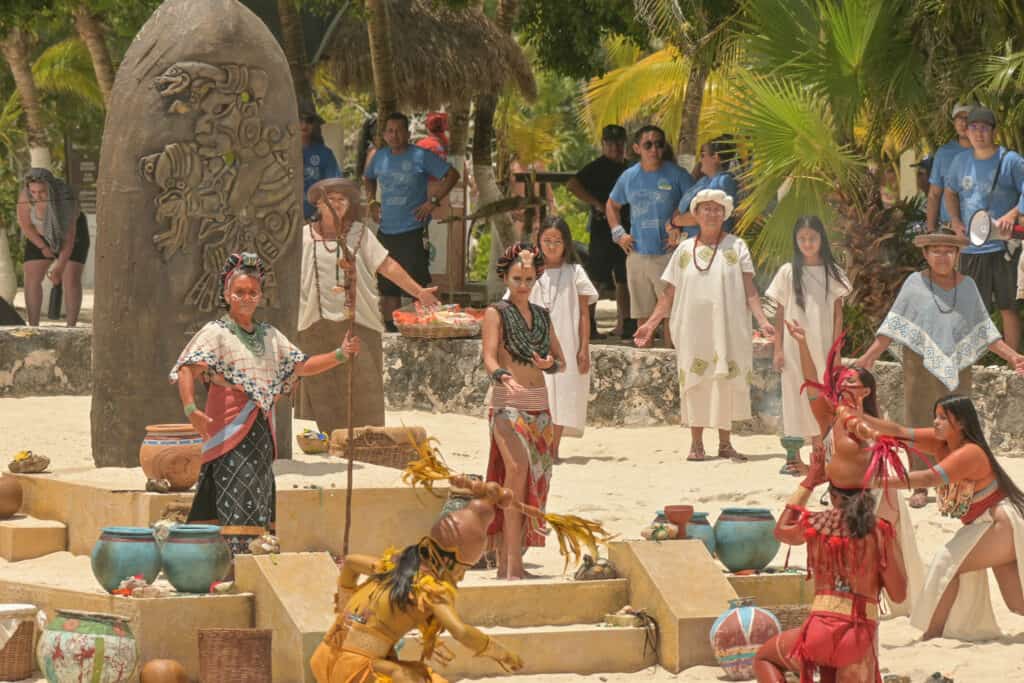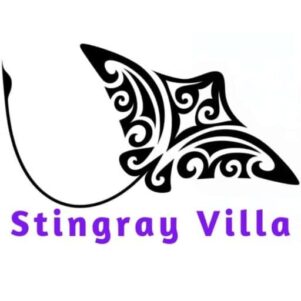Cozumel Mayan Ruins: Uncovering the Secrets of a Cool Civilization
Hey! Welcome to Cozumel Island! This island has 5 of the best Cozumel ruins, and we will explore the culture and beliefs of this ancient civilization and other ancient civilizations. From the oldest ruins at El Cedral to the most important site at San Gervasio, we’ll visit the majestic Mayan past and uncover the secrets of this cool civilization. Come along with us as we discover the ancient Mayan ruins and hidden Cozumel pyramids in the jungle of this Caribbean island.
Unearthing Clues to Cozumel‘s Ancient Past
But wait—here’s a mind-blowing twist! Back in the 1970s, archaeologists stumbled upon a jade artifact near a collapsed temple, and get this: it’s Olmec, dating all the way back to at least 600 BCE. Even though you won’t find buildings from that era still standing, this discovery hints that Cozumel’s story goes much deeper than anyone expected. Turns out, people were vibing on the island long before those classic Mayan structures ever went up.
What Does “Cozumel” Mean?
First fun fact—did you know “Cozumel” actually means “Island of the Swallows” in Mayan? That’s right! According to ancient legend, the island was considered sacred to Ixchel, the goddess of the moon. Swallows would migrate here as a sign of her blessing, and the name stuck. So next time you see a swift bird swooping overhead, remember: you’re experiencing a piece of Mayan history in real time.
Why Cozumel Stands Out
So, what makes Cozumel such a big deal among Mexican islands? Well, for starters, it’s not just famous for its coral reefs and beach bars—Cozumel is actually the third largest island in all of Mexico. Plus, when it comes to population, it’s second only to Isla Mujeres, making it both spacious and bustling compared to other offshore getaways.
You can really feel the energy here—local markets are lively, neighborhoods are vibrant, and there’s a sense of history pulsing through the island’s sandy soil. This unique combination of size and community means Cozumel isn’t just another dot in the Caribbean; it’s a true cultural and archaeological treasure trove.
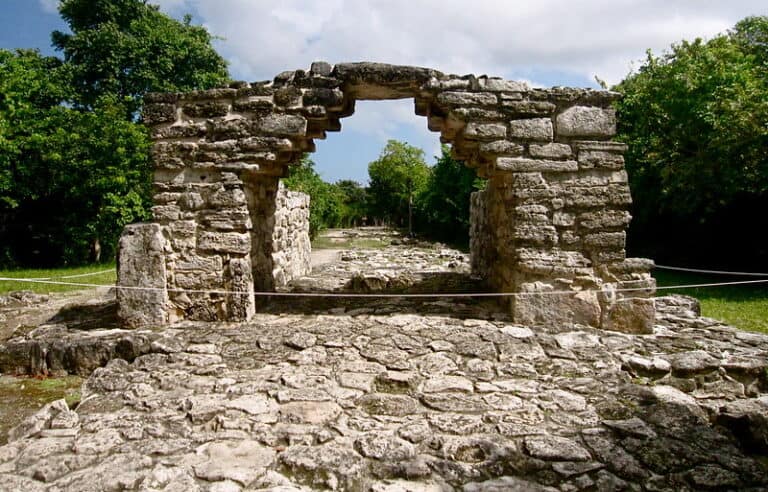
San Gervasio Mayan Ruins
San Gervasio Mayan ruins are the biggest archaeological site in Cozumel and one of the most important in the region. The Mayans considered it a sacred place to honor their goddess Ixchel. She was the supreme authority on love, fertility, and health in the Mayan belief system.
Among the most popular structures at San Gervasio are Las Manitas, where Lord Itzá de Cozumel lived over 1000 years ago. Also worth visiting are Casa Alta, Central Plaza, El Arco, Casa Grande, and Chi Chan Nah, among the most preserved buildings and ritual sites. Nohach Nah is one of the best-preserved buildings, retaining its original roof and architectural features.
At San Gervasio, you can learn about the Mayan way of life and spirituality while enjoying the architecture and craftsmanship of the structures. This site is a must-see for anyone interested in the Mayan ruins near Cozumel and the history and culture of the ancient civilization.
- Exploring San Gervasio’s Pathways and Platforms: One cool thing about exploring San Gervasio is how easy it is to get around the site. The pathways and platforms have been rebuilt over time, making them solid and safe for visitors—without taking away from the site’s authentic look and feel. You’ll notice the walkways blend right in with the jungle surroundings, letting you move through the ruins at your own pace. Feel free to stroll along these routes and use the platforms for some great photo ops or just to take in the view. They’re set up so everyone can get a close look at the ancient buildings, while still helping protect the ruins themselves. So, whether you’re a history buff or just want a cool backdrop for your next Instagram post, San Gervasio’s visitor-friendly paths have you covered.
- Guided Tours vs. Self-Guided Adventures at San Gervasio: When planning your visit to San Gervasio, you’ll have a big decision to make: guided tour or self-guided adventure? Each choice comes with its own perks and quirks, so here are a few things to consider before you start exploring Mayan ruins like Indiana Jones—sun hat, camera, and all!
- Guided Tours: Opting for a guided tour can be a great way to dive deep into the history and legends of San Gervasio. The local guides, often proud of their Mayan heritage, bring the ruins to life with stories, ancient secrets, and fun facts you might otherwise miss. If you love learning, asking questions, or just want to relax while someone else does the navigating, this option takes out the guesswork. On the flip side, tours sometimes mean traveling in larger groups, a more structured pace, and—let’s face it—a bit of “follow-the-leader” through the jungle.
- Self-Guided Exploration: Going self-guided gives you freedom—go where you want, take your own sweet time, and snap as many photos as you like without feeling rushed. It can be easier on the wallet, too. You’ll avoid the big crowds and can find quiet corners of the ruins perfect for soaking in the atmosphere or pretending you’ve discovered a hidden temple (we won’t tell). The trade-off? You might miss out on some fascinating stories and context that guides provide, but if independence is your thing, you’ll have a blast forging your own path.
- Exploring the Walking Paths at San Gervasio: If you’re wondering what it’s like to stroll around San Gervasio, picture this: well-marked pathways wind their way through lush jungle, weaving from one ancient structure to the next. Along these trails, you’ll notice signs politely reminding visitors not to climb on the ruins—these amazing stone buildings date back as far as 600 A.D., and preserving them is part of the magic.
- The Paths: Don’t worry, though! There are plenty of walkways and platforms where you’re welcome to explore and snap photos. Many of these are thoughtfully reconstructed to blend with the original surroundings, so you can take in the view without stepping on history. Some paths transform into mini jungle hikes, leading you deeper beneath the canopy and uncovering hidden ruins tucked among the trees. Expect the occasional muddy patch and a light sense of adventure as you wander. There’s even a beautifully maintained tourist path that follows the same route as the ancient Mayan road, complete with manicured grass and that incredible sense of standing where ancient travelers once walked.
- How to get to San Gervasio: San Gervasio is 4 miles east of San Miguel de Cozumel and on the main road. You can book guided tours through many travel agencies or take a taxi tour from one of the city’s top hotels.
- Hours: The site is open Monday to Sunday from 9:00 AM to 5:00 PM. General admission is 188 pesos (USD 10). The average visit to San Gervasio takes about 2 hours, so you have plenty of time to visit the different structures and learn about the site’s history and culture.
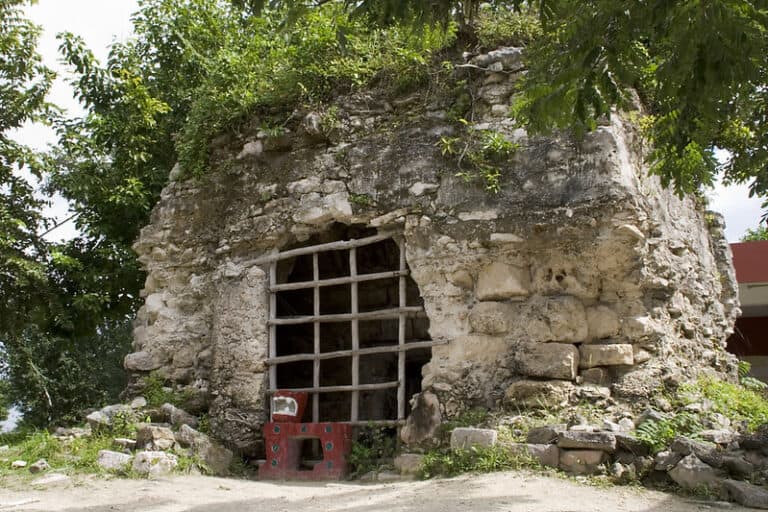
El Cedral Cozumel
In the town of El Cedral, the El Cedral Ruins are the oldest Mayan Ruins on the island, dating back to 800 AD. A white and red arch with crosses marks the entrance to the ruins. This was the historical capital of Cozumel, and all that remains is a small house-sized ruin. Despite its size, it’s open and worth visiting.
El Cedral hosts the Festival of Santa Cruz and El Cedral Fair. This 150+ year-old tradition, which lasts a week, commemorates an attack during the Caste War of Yucatan. It features fair, traditional food, live music, and bullfighting. You can also try traditional Mayan food during the festival and add to the cultural experience.
How to get to El Cedral
To get to the El Cedral ruins, head south of Cozumel on the highway to the town of the same name. If you’re coming from Playa del Carmen, you can take a ferry to Cozumel and visit the island’s different sites. Many tour operators offer combined El Cedral and San Gervasio tours, which you can book online or through your hotel. However, it might be hard to find tours that only visit El Cedral because of its location.
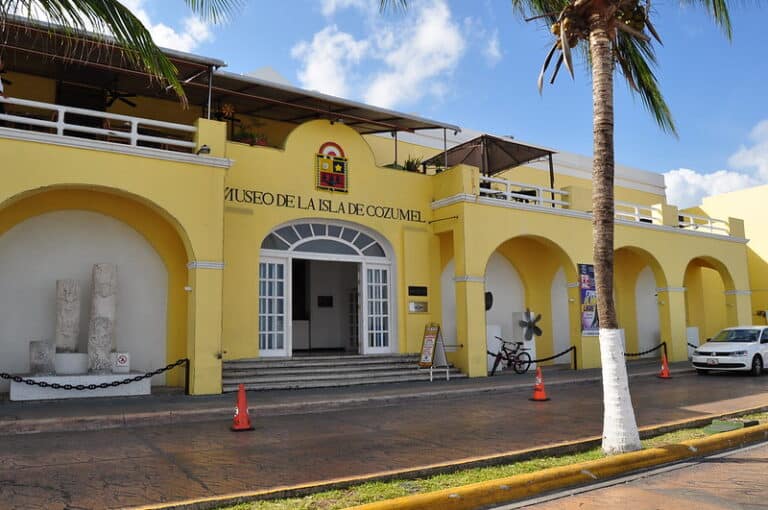
Cozumel Museum of Mayan Artifacts
Visit the Museo de la Isla, a Mayan cultural center, to learn about Cozumel and its people. This is the best museum on the island and was renovated and updated in 2020.
The museum has different galleries that display Cozumel’s natural history, environment, and wildlife. You will see great photos and videos of the coral reefs, the mangroves, and the animals that live here. You will also learn about the island’s human history and how it has changed.
Start your day here if you’re new to Cozumel. You’ll get an excellent overview of the island and its culture. You’ll also learn about local holidays and how they relate to the area’s history.
The Museo de Cozumel is a must-visit for anyone who wants to know more about this island. You’ll enjoy your time here and learn much about Cozumel’s past and present.
Cozumel Museum Hours: Tuesday – Sunday, 9 am-5 pm. $9.00USD
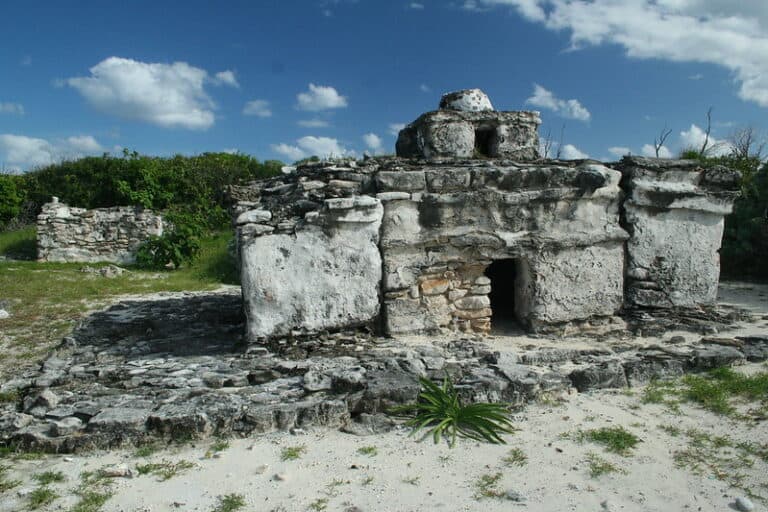
El Caracol – Cozumel Mayan Ruin at Punta Sur
Another place to visit in Cozumel is El Caracol, a small but interesting Mayan ruin part of the Punta Sur Ecological Park. The island’s municipal government runs this park and has a website for more information.
While El Caracol is a small ruin, Tulum is a notable walled port city that played a significant role in the Mayan trade.
The park has excellent views of the Caribbean Sea, so it’s perfect for nature and history lovers.
The park is a nice place to enjoy nature and wildlife. You can swim and snorkel in the clear water, see coral reefs and fish, and use the clean and comfortable bathrooms and changing rooms.
To get to El Caracol, drive along the park’s shore on a dirt road with great views. The ruin is near the crocodile lookout point, where you can also see them in their natural habitat.
El Caracol is an example of how the Mayans used their knowledge and skills to build structures for different purposes. They used this one as an observatory, and now it’s a lighthouse for navigation. You’ll see how this ruin has endured for centuries and is part of Cozumel’s Mayan legacy.
Punta Sur Ecological Park and El Caracol are a must-visit for history, culture, and nature lovers. You’ll have a great time here and learn about Cozumel’s past and present.
Was El Caracol Dedicated to the Mayan Goddess Ixchel?
El Caracol dates back to the late Postclassic period, around 1200 to 1500 AD. Many believe it may have been connected to worship of the Mayan goddess Ixchel, but no direct evidence has been found at the site to confirm this. While its age and architectural style suggest it could have held ceremonial importance, archaeologists have yet to uncover artifacts or inscriptions that clearly tie El Caracol to Ixchel. The connection remains a popular local legend rather than established historical fact.
When was El Caracol built?
El Caracol dates back to the late Postclassic period, between 1200 and 1500 AD. This means the structure has been standing for over 500 years, offering a fascinating glimpse into Cozumel’s ancient past.
Why is it called “El Caracol” (or “Tumba del Caracol”)?
The name “El Caracol,” which means “the snail” in Spanish, comes from the decorative snail shells found on the small dome atop this ancient temple. Because of its petite size, some also refer to it as “Tumba del Caracol,” or “snail tomb,” since its shape resembles a burial mound. Both names reflect the unique features of this little structure and add to its charm as one of Cozumel’s historical treasures.
Park Hours:
Please always check the official Punta Sur Park website for current hours. Admission is USD 19.00 for adults, USD 13.00 for kids 4-12, and free for kids under 4.
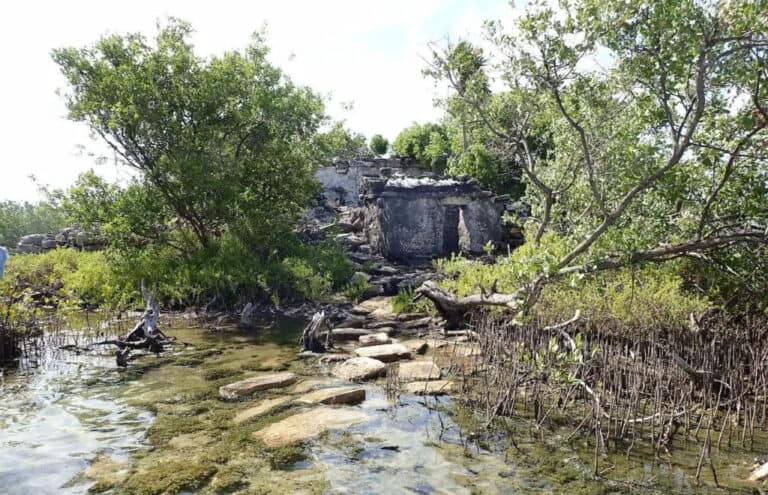
El Castillo Real – Cozumel’s Remote Mayan Ruin
Travelers looking to go off the beaten path should consider visiting El Castillo Real, one of Cozumel’s most intriguing yet overlooked Mayan sites. The name means “royal castle,” and true to its title, this substantial temple stands out as one of the largest ruins on the island.
The main structure of El Castillo Real sits atop a manmade platform or mound, making it distinct from other smaller temples you might see around Cozumel. While it’s not as famous as Tulum’s El Castillo, it shares several architectural traits and is believed to have been constructed in the same era, around the 10th or 11th century CE. If you’re a fan of Mayan history or design, you’ll appreciate the similarities in how these sites were built to serve as both ceremonial centers and markers along the coastline.
Getting to El Castillo Real is an adventure in itself. The temple is located along Cozumel’s rugged northeastern coast, in a part of the island rarely visited by most tourists. This isn’t a spot you stumble upon by accident, access usually requires a sturdy 4×4 vehicle to manage the rough, sometimes overgrown roads. For the especially adventurous, you can try reaching it by bike, but be prepared: the distance and challenging terrain mean it’s best suited for those comfortable with a day of cycling and exploring in remote areas.
When you arrive, don’t be surprised if you have the place almost entirely to yourself. Very few others make the trek out here, giving you a peaceful, almost private experience with Cozumel’s ancient past. If you’re lucky, you might meet a local or two who know stories about the area and its history.
El Castillo Real offers a glimpse into a quieter chapter of Mayan history and a sense of discovery you won’t find in more crowded spots.
Cozumel’s Ancient Mayan Roads and Mysterious Markers
As you explore the lesser-known northern mangroves, keep an eye out for traces of Cozumel’s ancient sacbes—white roads built by the Maya long before modern pavement arrived. These raised limestone paths once crisscrossed the island, linking settlements, ceremonial centers, and coastal routes. While the southern coast is now easily accessed by car, the north tells a different story, where sandy trails give way to glimpses of these old Mayan roads lost in the brush.
Along the route, you might notice small stone constructions set beside the sacbes. Some look like modest altars, while others serve as distance markers or shrines. Their exact purpose remains a bit of a mystery—archaeologists have several theories, but no definitive answers. Some say they guided travelers or marked resting points on pilgrimages to temples like San Gervasio, a place dedicated to the Maya goddess Ixchel. Others believe some of the markers were added in recent years, blending ancient traditions with modern curiosity.
If you’re lucky, your paddleboard guide might point out a weathered stone circle or stacked altar tucked among the mangrove roots—reminders of how the Maya once navigated Cozumel’s wild side. This is a unique chance to spot pieces of Cozumel’s hidden history that most visitors never see.
Mayan Ruins Cozumel at the North End of the Island
If you want to experience visiting Mayan ruins differently and excitingly, try the stand-up paddleboard tour of the north mangroves with DeLille Watersports. This is one of the best tours in Cozumel, and you’ll see the island from a new perspective.
This tour is not for everyone. You need to be in shape and comfortable in the water. But if you are up for it, you’ll have a great time. You’ll paddle through the mangroves and see some of the island’s Mayan structures and old roads that most tourists don’t see.
Don’t worry about anything. DeLille’s guides are very professional and friendly. They’ll help you with everything and ensure you’re safe and happy. As you paddle along, they’ll also tell you about Cozumel’s history and culture.
Stand-up paddleboard tour of the north mangroves is for nature lovers and thrill seekers. You’ll love this and see Cozumel differently.
Book Your SUP Tour of Mangroves
If you want to book the tour, contact DeLille Sports. They may limit access to the area on your chosen day due to weather and wind conditions. Contact the DeLille staff guides to set everything up.
On the tour day, you’ll meet the DeLille boat at the island’s north marina. From there, you’ll take a motorboat to the small access point, where you’ll launch your paddleboards. DeLille’s guides will be with you every step of the way to ensure you have a safe and fun experience. Ask them questions before or during the tour.
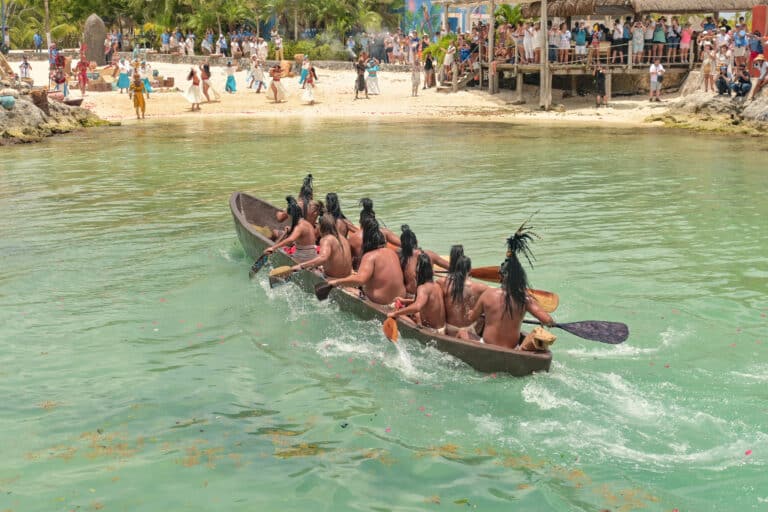
Sacred Mayan Crossings
One of the coolest things to see in Cozumel is the Sacred Mayan Crossings. This annual event happens in May or June and recreates the ancient pilgrimages the Mayans used to make to Cozumel. This is one of the biggest cultural events in the Yucatan Peninsula and attracts participants and spectators from all over the region. Hundreds of men and women dressed in Mayan costumes paddle from Playa del Carmen to Cozumel and back in two days in traditional canoes. The event starts with a journey to Xcaret, an important archaeological site.
In addition to the Sacred Mayan Crossings, the Coba Mayan ruins are another significant site worth exploring for their impressive pyramids and lush jungle surroundings.
They spend the night doing rituals and prayers to Ix Chel, the Mayan goddess of fertility and the moon. They ask for her blessings and guidance as they prepare for their journey to Cozumel. They wait for sunrise to start their journey across the sea. This is a very spiritual experience that shows how the Mayans respect nature and their ancestors. The event keeps their culture alive despite all their challenges throughout history.
When they arrive at Cozumel, they go to the main temple and make offerings to Ix Chel. They leave them there overnight so she can talk to them through signs and messages. They believe she will give them good luck and prosperity for their communities and families.
The next day, they return to their canoes and go back to Playa del Carmen. As they paddle, they feel connected to nature and its elements: the sea, the wind, and the stars. They consider this journey mystical because it changes them spiritually and emotionally.
This annual ceremony is significant for the Mayans because it honors their goddess and ancestors. They remember how their ancestors were great sailors and traders who used the sea as a source of wealth and knowledge. Through the ceremony, they feel connected to nature, which they believe is alive and gives life to everything on earth. The Cozumel pilgrimage shows how much the Mayans respect the divine and how proud they are of their culture and history.
Cozumel’s History: From the Mayan Civilization to Today’s Tourist Destination
Welcome to Cozumel, a history and culture-rich island! The Mayans settled here 2000 years ago, and Cozumel was a sacred place for Mayan women to worship Ix Chel, the goddess of fertility, medicine, midwifery, and weaving. Cozumel is part of the larger Riviera Maya region, which includes other significant sites like Chichen Itza, one of the Seven Wonders of the World. The region is known for its rich cultural history and natural beauty.
Mayan women would travel to Cozumel in wooden canoes with all their belongings. They would camp in caves along the coast at night and prepare for the ceremony over the next few days. They would bathe in the sea and anoint their bodies with salt, water, and herbs.
Today, the archeological site of San Gervasio is in the island’s center as a reminder of the Mayan civilization and their worship of Ix Chel. It’s a great place to visit and learn about the Mayans.
As we continue our journey through Cozumel, we must acknowledge the impact of the Spanish Conquest on this beautiful island. In the early 1500s, Cozumel was a thriving urban area with 40,000 inhabitants. But in 1519, Hernan Cortes arrived on the island, bringing destruction and smallpox. The population dropped to 30 people, leaving the Mayan civilization in ruins.
Cozumel remained uninhabited for centuries until 1847 when a few families fleeing the Spanish retaliation during the Caste War arrived on the island. These were the first permanent settlers, and they named their settlement San Miguel de Cozumel, which is the beginning of what we now know as the town of Cozumel.
The island’s population grew in the 19th century, and by the 20th century, it had grown to over 100,000 people. With its natural beauty and rich history, Cozumel has become a tourist destination and a popular tourist stop for cruise ships.
As the tourism industry grew, they built Cozumel International Airport, and now it’s easier for visitors to get to and from the island. Cozumel is still a top tourist destination, offering visitors a mix of history, culture, and natural beauty.
Conclusion
You can visit many Mayan sites in Cozumel. They are of different sizes and purposes, but all show the beauty and wisdom of the Mayan culture. The locations and architecture of these ancient ruins will surprise you. From El Cedral, the oldest site on the island, to San Gervasio, the most important site to worship Ix Chel, you will learn a lot about the history and culture of this region. Join us on a tour of Cozumel’s Mayan heritage and discover the wonders of this ancient civilization.
Why Book With Us?
Book through this website; we guarantee you’ll get the lowest price online. You’ll be dealing directly with us, the owners, and we never charge booking fees so you will save up to 30% of the cost on sites like Airbnb. Book our Downtown Villa in Cozumel here.

